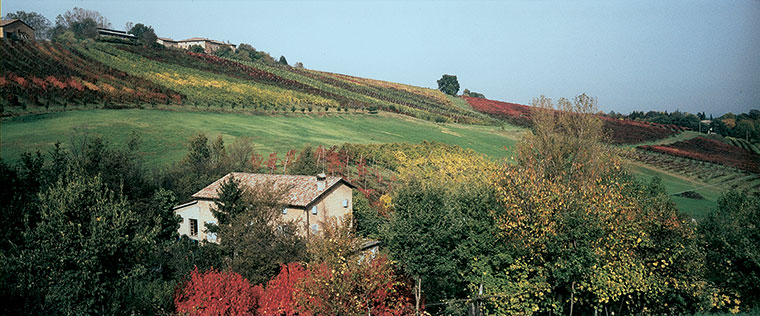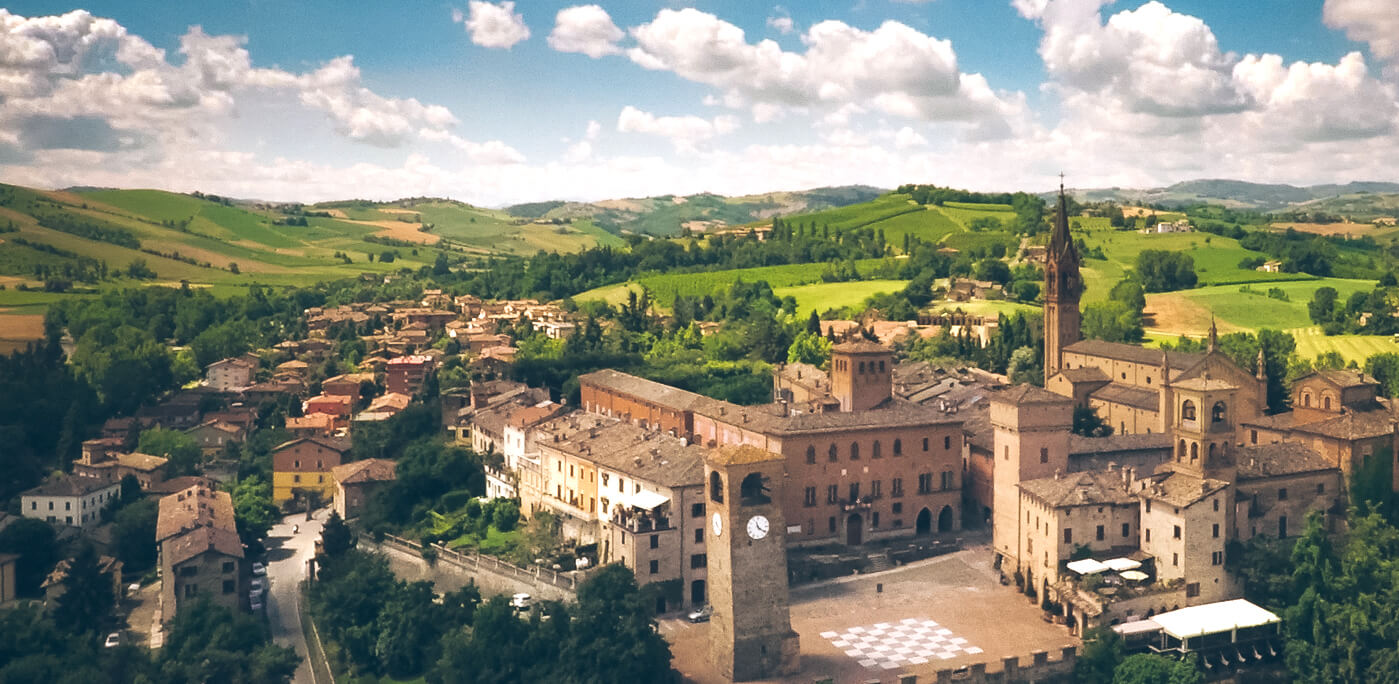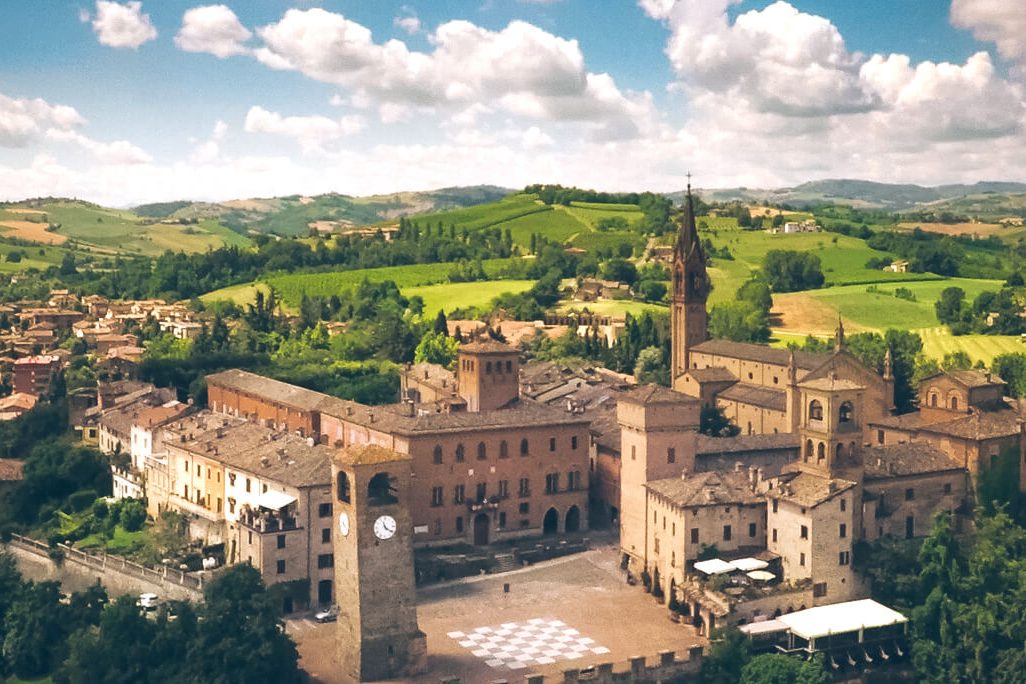Italy, a country well-known for its beauty, hides undiscovered neighborhoods far from the typical touristic routes. In Emilia Romagna, the region surrounded by Lombardy, Veneto and Tuscany, there are places that are so surreal and beautiful that when you first see them, you think they must be from a children’s storybook. This piece of Italy is renowned for its culinary delights, its wine and food tradition and for being the heart of the Italy’s Motor Valley, the homeland of some of the most famous luxury sports cars in the world.
Our itinerary will lead you on a discovery of the land of Lambrusco Grasparossa, a place that can be enjoyed to the full through Castelvetro di Modena: a small town nestled between vineyard-covered hills.
This village is a veritable treasure chest offering the gems of its cultural heritage such as the remains of the fortress walls and the main square Piazza Roma, the beating heart of the town, offering panoramic views over rolling hills. However, our attention is caught by the black and white paving forming a highly original chess board in the square; this special feature has led to Piazza Roma being attributed the alternative name of “Piazza della Dama” (Chequers Square), which every two years becomes the stage for a live chess game with human figures.
The suburb of Castelvetro continues with its attractions, where visitors can admire its historical buildings like Palazzo Comunale, Palazzo Rinaldi, and the enchanting clock tower Torre dell’Orologio (Clock Tower) that dominates the square and is undoubtedly one of the outstanding symbols of the town.
The Clock Tower was built between the 11th and 12th century and represents what remains of the ancient fortification on the eastern side of the castle; in the 12th-13th century it was probably equipped with a bell used to summon the local people to the square, while a sundial, clearly visible from the southern side, still shows the passing of time today.
Here we leave the square and head towards the magnificent church with its Neo-Gothic architecture, built in 1897.
Walking along the little lanes of this tiny village in the heart of the hilly Modena countryside, we discover small workshops from the past and places for refreshment, especially the classic trattorias with a rural character where it is possible to eat fresh homemade stuffed pasta, dressed with an excellent, delectable cream made with traditional Modena balsamic vinegar and Parmigiano Reggiano, accompanied by the red sparkling wine Lambrusco Grasparossa di Castelvetro.

If you would like to experience the wine and food of this part of Emilia to the full, we suggest that you visit its gentle hills to explore the local farms, sampling the sparkling red wine, Lambrusco Grasparossa, and the famed traditional balsamic vinegar of Modena, perhaps accompanied by a piece of locally-made Parmigiano Reggiano.
Castelvetro is a place where you can discover the magic of the tradition, the history and culture , of this strip of Emilia, and these elements are the focal points of astonishing itineraries that wind through the region, which can be reached in just twenty minutes from Modena, or in around a half hour from Bologna.
On the hunt for ancient flavors and traditions
If you would like to experience the wine and food of this part of Emilia to the full, we suggest that you visit its gentle hills to explore the local farms, sampling the sparkling red wine, Lambrusco Grasparossa, and the famed traditional balsamic vinegar of Modena, perhaps accompanied by a piece of locally-made Parmigiano Reggiano.
The Grasparossa variety of Lambrusco is produced in this hilly zone south of Modena and is distinguished by its intense ruby red color with purple reflections and its intense fruity aroma, reminiscent of mature woodland berries. To enjoy the best experience of this sparkling, enveloping red wine, we suggest that you stop by one of the farms in the Castelvetro, such as the Cleto Chiarli Tenute Agricole winery, which in addition to being one of the oldest Lambrusco producers in its different varieties, boasts a stupendous estate among the hills: the Tenuta Cialdini, which has been owned by the family for more than 130 years. This fascinating estate covers more than fifty hectares of vineyards. Throughout the year, you can visit the winery and pause to taste the Lambrusco in a fully restored nineteenth-century villa, which also has beautiful stables.
Meanwhile, if you are looking to delight the palate with typical dishes from the Modena wine and food traditions, the area of Castelvetro and Levizzano offers a range of possibilities. Over the course of our wanderings we discovered an enchanting place, Acetaia Sereni, built at the top of a hill, where traditional Modena balsamic vinegar is produced along with other typical local produce, including delicious cherry and plum jams.
Acetaia Sereni is not only a place where traditional balsamic vinegar is made, it is also offers accommodation in an adjacent holiday farm, where you can stay the night and enjoy traditional Modena dishes, such as tortellini in broth, stuffed pasta, fillet steak with balsamic vinegar and “tigelle”, traditional small bread rounds enjoyed with exquisite cold cuts, like Parma ham.
If you are curious and keen to find out how Modena’s “black gold” is produced, Acetaia Sereni offers guided tours of the estate, where the casks are looked after with painstaking care. It is a surreal atmosphere that will enchant you with its fragrances of must and acidic aromas wafting from the little wooden casks. Another particularity of this small holding is that it is partly dedicated to cultivating olives. Thanks to its special microclimate, the estate is surrounded by more than 800 olive trees from Calabria, which provide the family with excellent extra virgin olive oil year after year.
History, architecture and rural traditions are the cornerstones of this strip of Emilia, and these elements are the focal points of wondrous historical, artistic and wine and food itineraries that wind through the region, which can be reached in just twenty minutes from Modena, or in around a half hour from Bologna.




























